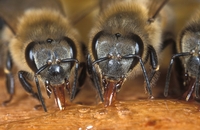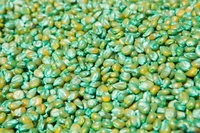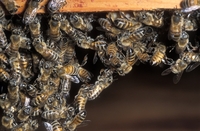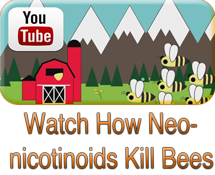What's at risk?
Substance
 A neonicotinoid is a molecule whose chemical structure is very close to the one of nicotine found in tobacco. Its structure makes it much more specific to target the insect nervous system than the one of mammals. Neonicotinoids bind to cholinergic nicotinic post-synaptic receptors of the insects.
A neonicotinoid is a molecule whose chemical structure is very close to the one of nicotine found in tobacco. Its structure makes it much more specific to target the insect nervous system than the one of mammals. Neonicotinoids bind to cholinergic nicotinic post-synaptic receptors of the insects.
Mode of action
Neonicotinoids are neurotoxic insecticides: they hyper-stimulate honeybees’ nervous system and can induce a wide range of effects, from sublethal to lethal. They act in an irreversible way, which means that any additional dose honeybees face will induce additional effects.
Toxicity
Hyper-stimulation of honeybees’ nervous system can have a wide range of consequences on honeybees and induce disorientation, behavioural troubles, learning and memory impairment, somatic abnormalities.
Why are neonicotinoids’ so toxic compared to other insecticides?
 Neonicotinoids are classified as systemic compounds. This means they are soluble in water and may be absorbed by the roots of the plants. Seeds of plants are coated with neonicotinoids and sawn in the ground. While growing, the plant absorbs neonicotinoids by its roots and the entire plant is contaminated: sap, tissues, flowers, nectar and pollen. This is a very efficient way to protect predators of the plant as it will be toxic its life cycle long. But one of the collateral damage is the fact that neonicotinoids are present in pollen and nectar and thus available to bees and other pollinators.
Neonicotinoids are classified as systemic compounds. This means they are soluble in water and may be absorbed by the roots of the plants. Seeds of plants are coated with neonicotinoids and sawn in the ground. While growing, the plant absorbs neonicotinoids by its roots and the entire plant is contaminated: sap, tissues, flowers, nectar and pollen. This is a very efficient way to protect predators of the plant as it will be toxic its life cycle long. But one of the collateral damage is the fact that neonicotinoids are present in pollen and nectar and thus available to bees and other pollinators.
Contrary to what is often being said by the pesticides industry, the concentration of neonicotinoids found in nectar (a few ppb) and pollen (5-10 ppb) is toxic to bees. It does not directly kill bees but induce sublethal effects as the ones described previously.
Why are bees so sensitive to neonicotinoids?
 Toxicity of neonicotinoids on bees is up to 7,000 times higher than DDT. Furthermore, in the past, foraging honeybees were sprayed by insecticides and died instantly (acute toxicity) in the field. No forager could return to the hive and the remaining bees from the hive were thus not intoxicated. The lost of forager bees weakened a little bit the honeybee colony but it could generally cope with it. With systemic insecticides, sublethal, i.e. non-killing, doses of toxic are presented to honeybees in nectar and pollen and foragers do not die but nervous system is altered. They are still able to go back to the hive with their poisonous load of nectar and contaminate the entire colony. A hive placed in an oilseed rape area will be confronted during more than one month to toxic nectar (in some countries nearly 100% of oilseed rape is using neonicotinoid-coated seeds).
Toxicity of neonicotinoids on bees is up to 7,000 times higher than DDT. Furthermore, in the past, foraging honeybees were sprayed by insecticides and died instantly (acute toxicity) in the field. No forager could return to the hive and the remaining bees from the hive were thus not intoxicated. The lost of forager bees weakened a little bit the honeybee colony but it could generally cope with it. With systemic insecticides, sublethal, i.e. non-killing, doses of toxic are presented to honeybees in nectar and pollen and foragers do not die but nervous system is altered. They are still able to go back to the hive with their poisonous load of nectar and contaminate the entire colony. A hive placed in an oilseed rape area will be confronted during more than one month to toxic nectar (in some countries nearly 100% of oilseed rape is using neonicotinoid-coated seeds).
Alone, a honeybee cannot live. It needs its family: the honeybee colony. Honeybee is a social insect: communication is fundamental to the well-being of the hive. Honeybees permanently communicate as it is the basis of a social structure. Without communication, the different honeybee casts do not fulfil their duties, cannot exchange key information such as where interesting sources of nectar are or what is the need for thermoregulation of the inside of the hive. Neonicotinoids thus disrupts communication in the hive and weaken the honeybee colony.
Insects have a range of biological mechanisms to detoxify the chemicals they are confronted to. Honeybees are genetically poor in detoxification mechanisms: they possess half of the most important detoxifying enzymes, compared to some other insects (Anopheles, Drosophila). Scientists thus think this is the reason for increased susceptibility to pesticides. One of the evolutionary hypotheses to explain this weakness is that it has been compensated by social structure: by its hygienic behaviour and collaboration between individuals, honeybees did not need so many detoxifying genes as they lived in a safe environment: the hive. But millions of years of natural selection of honeybees did not take into account the fact honeybees would be confronted to synthetic toxics invented by men.
How could insecticides so harmful to honeybees be authorised?
In order to obtain a European authorisation, industries must carry out toxicity assessment tests to evaluate the toxicity of their products to honeybees. Many failures of the system lead to this environmental disaster.
1. The industry made its own rules. The toxicity assessment scheme of pesticides to bees was not produced nor modernized by EU institutions but the European Commission asked the European and Mediterranean Plant Protection Organization (EPPO) to produce the guidelines of the test and EPPO requested the International Committee on Plant-Bee Relationship (ICPBR) to create the guidelines.
ICPBR Bee protection Working Group is an informal group of scientists in which the industry has always been present. Currently, industry funds the meetings of ICPBR and are highly represented in the working group (Bayer CropScience Ag, BASF Ag, Syngenta Ltd, Dow agroscience, E.I. Dupont de Nemours). Industry has thus produced its own rules to assess the toxicity of their own products and the European Commission has accepted this conflict of interest. Furthermore, some scientists present in the ICPBR have close links with the industry (common publication of scientific articles) and their independence is highly questionable.
In May 2012, the European Food Safety Authority (EFSA) has produced a report on the current assessment methods for the evaluation of pesticides toxicity to bees. In this report, EFSA stresses very important scientific breaches that render the results of the tests improper to be used by risk managers. For instance, field tests are carried out with 1 ha of treated field next to which hives are placed to assess the toxicity of a pesticide on the hives. But in reality, the foraging area of a honeybee is 2,500 ha and in intensive agriculture areas, oilseed rape, maize or sunflower represent several hundreds of hectares. The results of the toxicity assessments provided by the industry are thus not reliable. This kind of approach has been carried out by ICPBR.
Identical ethical questions can be raised on the work carried out by the OECD bee working group where industry is also present and participate to the production of their own rules (e.g. larval toxicity tests).
2. Toxicity assessment schemes were created to assess contact toxicity for sprayed insecticides. Spraying of pesticides on honeybees induces contact acute toxicity. Systemic insecticides (that are ingested) were not taken into account in the evaluation process. Sublethal and chronic toxicity assessment were not carried out, nor larvae toxicity tests.
Despite the fact neonicotinoids have been present on the market for 20 years now and despite beekeepers’ claims and the now important number of independent scientific publications proving harm to bees at field-relevant doses, up to date, no sublethal and chronic toxicity assessment tests guidelines have been requested from the industry by the European Commission. All pesticides available on the market should thus be re-evaluated according to their sublethal and chronic toxicity to bees, beginning with neonicotinoids.

